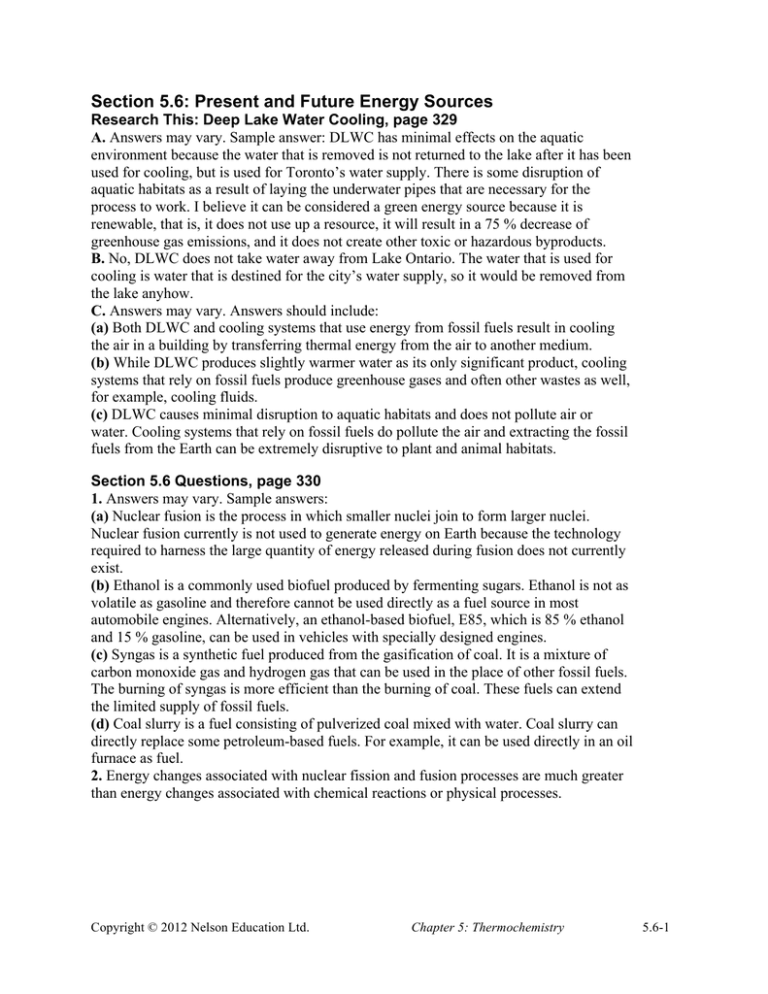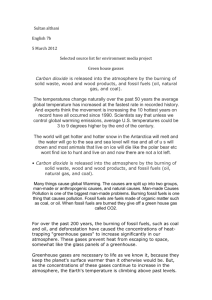Section 5.6: Present and Future Energy Sources
advertisement

Section 5.6: Present and Future Energy Sources Research This: Deep Lake Water Cooling, page 329 A. Answers may vary. Sample answer: DLWC has minimal effects on the aquatic environment because the water that is removed is not returned to the lake after it has been used for cooling, but is used for Toronto’s water supply. There is some disruption of aquatic habitats as a result of laying the underwater pipes that are necessary for the process to work. I believe it can be considered a green energy source because it is renewable, that is, it does not use up a resource, it will result in a 75 % decrease of greenhouse gas emissions, and it does not create other toxic or hazardous byproducts. B. No, DLWC does not take water away from Lake Ontario. The water that is used for cooling is water that is destined for the city’s water supply, so it would be removed from the lake anyhow. C. Answers may vary. Answers should include: (a) Both DLWC and cooling systems that use energy from fossil fuels result in cooling the air in a building by transferring thermal energy from the air to another medium. (b) While DLWC produces slightly warmer water as its only significant product, cooling systems that rely on fossil fuels produce greenhouse gases and often other wastes as well, for example, cooling fluids. (c) DLWC causes minimal disruption to aquatic habitats and does not pollute air or water. Cooling systems that rely on fossil fuels do pollute the air and extracting the fossil fuels from the Earth can be extremely disruptive to plant and animal habitats. Section 5.6 Questions, page 330 1. Answers may vary. Sample answers: (a) Nuclear fusion is the process in which smaller nuclei join to form larger nuclei. Nuclear fusion currently is not used to generate energy on Earth because the technology required to harness the large quantity of energy released during fusion does not currently exist. (b) Ethanol is a commonly used biofuel produced by fermenting sugars. Ethanol is not as volatile as gasoline and therefore cannot be used directly as a fuel source in most automobile engines. Alternatively, an ethanol-based biofuel, E85, which is 85 % ethanol and 15 % gasoline, can be used in vehicles with specially designed engines. (c) Syngas is a synthetic fuel produced from the gasification of coal. It is a mixture of carbon monoxide gas and hydrogen gas that can be used in the place of other fossil fuels. The burning of syngas is more efficient than the burning of coal. These fuels can extend the limited supply of fossil fuels. (d) Coal slurry is a fuel consisting of pulverized coal mixed with water. Coal slurry can directly replace some petroleum-based fuels. For example, it can be used directly in an oil furnace as fuel. 2. Energy changes associated with nuclear fission and fusion processes are much greater than energy changes associated with chemical reactions or physical processes. Copyright © 2012 Nelson Education Ltd. Chapter 5: Thermochemistry 5.6-1 3. Answers may vary. Sample answer: The statement that said that the energy we get from fossil fuels came from the Sun is true. Fossil fuels form from the decaying remains of plants and animals, which are then subjected to high temperatures and pressures beneath Earth’s surface for thousands of years. Animals get their energy from either plants or other animals that eat plants, and plants get their energy from the Sun through the process of photosynthesis. The process of photosynthesis converts captured solar energy to chemical energy. 4. Answers may vary. Sample answer: The advantages of burning coal and gasoline for energy are mainly lower production costs, convenient storage, and easy transportation. Coal and gasoline are easily available and both release more energy during combustion than other fuels. Coal is a fossil fuel formed from decaying plant matter that has been buried for millions of years. Gasoline is collected from fractional distillation of crude petroleum. Currently all the infrastructure is built and has been in operation for more than half a century, from the drilling to the transport of the fuel to the refining process all the way to the consumer purchase of the fuel. The combustion of coal and gasoline produces carbon dioxide gas and water vapour, which are released into the atmosphere where they contribute to global warming and climate change. Climate change has been shown to lead to loss of species due to changes in habitats. The burning of these fuels also releases other pollutants. For example, the combustion of coal that contains high quantities of sulfur releases sulfur dioxide gas, SO2(g), which leads to acid precipitation. Extracting and transporting fossil fuels can be dangerous, as we have seen in recent global events, such as the 2010 oil leak in the Gulf of Mexico. 5. The burning of gasoline releases 14.9 kJ more energy per gram than burning coal. This makes gasoline more efficient as more energy is produced from the same mass of fuel. 6. (a) Answers may vary. Sample answer: The high per person energy usage in Canada could be due to the cold climate and heavy industries. (b) Answers may vary. Sample answer: Canadians could reduce their energy consumption by using low energy consumption transportation methods, taking control of temperature and use appliances efficiently. For example, whenever possible, walk, bike, car pool, or use mass transit; set your thermostat in winter to a lower temperature; switch to the use of energy-efficient appliances and turn off appliances at times when they are not in use. However, using mass transit is not possible when it is not available. You need to put on more clothing in winter when the thermostat is set to a lower temperature. Energy-efficient appliances are usually more costly. For certain appliances, such as the refrigerator, they should not be turned on and off as desired. 7. (a) The advantages of using hydrogen as a fuel source for cars are that hydrogen has a high enthalpy of combustion and that the only product of its combustion is water vapour. Hydrogen gas releases about 2.5 times the quantity of energy per gram released by the combustion of natural gas. Water vapour is not an air pollutant so hydrogen is a very clean burning fuel. (b) Hydrogen cars are not a viable option at this time because the fuel used—hydrogen gas—is currently very expensive to produce and challenging to transport and store. (c) Answers may vary. Students’ answers should include reasoning around cost and efficiency of production, storage, and transport of hydrogen gas. Copyright © 2012 Nelson Education Ltd. Chapter 5: Thermochemistry 5.6-2 8 (a) Answers may vary. Sample answer: According to the Toronto Hydro website, the sources of electrical energy that power the city of Toronto are burning coal, nuclear power, hydroelectric energy, burning natural gas, and renewable energy sources. (b) Answers may vary. Sample answer: According to the Toronto Hydro website these power sources deliver 24 746 GW-hours (gigawatt-hours) (W = J/s) of power for the city of Toronto. (c) Answers may vary. Sample answer: As of 2012, according to the city of Toronto website, one of the alternative energy programs in the city is the SolarCity Program. The SolarCity program promotes the use of solar thermal and photovoltaic generation equipment on city and community-owned facilities and residences. Solar power can displace emissions from fossil fuels used for electricity generation or heating, especially during periods of peak summer energy demand when air quality may also be at its worst. Copyright © 2012 Nelson Education Ltd. Chapter 5: Thermochemistry 5.6-3





